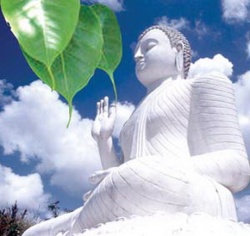The Five Aggregates of Self
The five aggregates of self (skandhas) – the elements whose aggregate continuity creates the illusion of a permanent and substantial self-existence:
A. Form (Rupa) - Materiality; physical form, the body. The body itself has no consciousness. The materiality of a dead body is the same as that of a living body. It does not possess any faculty of knowing. In fact, materiality does not possess the faculty of knowing an object in either a dead or a living body. It is only when the body is invested with life that there is consciousness, yet this consciousness is inseparable from the physical body.
B. Consciousness (Vijnana) - Mentality; awareness, the mind, the inner vision. The element of the mind is what has, holds and knows an object, while that of materiality does not. This defines consciousness - beholding an object. Mentality is that which knows an object and which comes into being depending on materiality. It is called Nama in Sanskrit because it inclines (namati) towards an object. It does so through the lens of the senses, but is should not be mistaken as just being the senses. It uses the senses as a sort of window to perceive objects.
C. Sensory Feelings (Vedana) - The lenses, windows or filters through which consciousness perceives objects of consciousness. There are two basic components: the six sense faculties (eye, ear, nose, tongue, body, & thinking mind) and the six sensations (sight, sound, smell, taste, touch, & dharmas or elements of reality). In contacting each other, there are six kinds of consciousness produced. Thus there are a total of eighteen realms of the mind.
D. Acts of Will, Volition (Samskara) - Acts of consciousness (or sub-consciousness if unawakened), acts of intent, the doing of things through the body, the mouth and the thinking mind, which initiate karmas (deeds that help create the retribution that is our destiny). Whereas sensory feelings are 'incoming' perceptions (coming from the object of consciousness), acts of will are 'out-going' actions (coming from within the consciousness or sub-consciousness). Sensory feelings are the medium through which we perceive whereas acts of will (volition) are the initiatives by which we act.
E. Conceptualization (Samjna) - The rationalizing faculty of the mind. This is the faculty that interprets, categorizes and ‘makes sense’ of what we perceive and do. In doing so it creates concepts, which codify realities (dharmas) into sensory data; thoughts, views, words, images, etc. Sensory perceptions are invested with meaning. It is here that the idea of a self is established as a basis for reasoning and discernment. Realities (dharmas) are endowed with a 'self' (a name) in order to distinguish and identify them. When perceptions and acts of are differentiated into concepts, these differentiations create aspects of duality and limitless aspects of multiplicity which are used to categorize and associate sensory perceptions.
